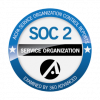 During the past few decades, financial crimes have only become more common. Because there are more ways than ever to process payments, there are also more apps that have to be sealed. As a result, both government institutions and financial organizations are looking for ways to prevent money laundering from taking place. That is why it is important for every company to have a firm anti-money laundering (AML) compliance program in place.
During the past few decades, financial crimes have only become more common. Because there are more ways than ever to process payments, there are also more apps that have to be sealed. As a result, both government institutions and financial organizations are looking for ways to prevent money laundering from taking place. That is why it is important for every company to have a firm anti-money laundering (AML) compliance program in place.
As an overview, AML refers to all legislation, policies, and procedures in place that force financial institutions to monitor their clients carefully and actively play a role in preventing money-laundering from taking place. There are strict AML laws that require financial organizations to report any suspected financial crimes that they detect to the appropriate authorities.
How Does Money Laundering Happen?
The objective of the anti-money laundering programs is to prevent criminals from taking illicit funds and feeding them directly into the financial system. The goal of money laundering is to hide the true source of money. Therefore, criminals will take illicit funds, enter them into the financial system, wash them with legitimate money, and then remove laundered money on the other side. If money laundering is successful, it is impossible to tell the difference between illicit financial funds and legitimate financial funds. Because financial organizations are often used, unknowingly, as a middleman to wash illegal money, they are also expected to play a major role in preventing this activity from taking place.
The Financial Action Task Force
It is important for all organizations to keep up with the latest rules and regulations when it comes to anti-money-laundering programs. One of the easiest ways to do so is to keep up with information that has been published by the financial action task force. Often shortened to the FATF, this organization is responsible for creating most of the anti-money-laundering standards that are used today. The vast majority of countries all over the world follow these standards.
Furthermore, the FATF is also responsible for keeping an eye on countries and organizations that do not have proper legislation and protection in place regarding money laundering. Therefore, they are also responsible for motivating countries to improve the strength of their anti-money-laundering programs. Now, the FATF has more than three dozen countries it counts among its membership.
Compliance Programs: Employee Training Is the Cornerstone
Today, just about every organization is expected to have anti-money-laundering programs in place. No matter what industry in which someone works, there is a good chance that money laundering is a risk. The reality is that it is impossible for a single task force to keep an eye on every transaction that takes place in every industry. Therefore, organizations are expected to have strong compliance programs in place to train employees regarding how to spot money laundering when it happens.
In order for organizations to have a strong AML compliance program, there are a few key points that have to be covered. These include:
- Employees have to be able to spot red flags that could indicate money laundering in their specific industry.
- Employees should be shown case studies regarding how money laundering takes place, is detected, and is caught.
- All employees need to know exactly how to respond if they believe they have spotted an instance of money laundering.
- Employees need to be kept up-to-date on the latest rules and regulations regarding money laundering, particularly those specific to their jurisdiction and their industry.
- Employees should also have access to data regarding instances of money laundering that may have been detected in their specific organization.
When an AML compliance program is instituted properly, employees should be able to easily verify the source of any money that is being taken into the organization.
The Future of AML Programs
So far, AML compliance programs have been successful in reducing instances of money laundering. Now, there are specific anti-money-laundering software programs that are increasingly being used to detect any potential criminal financial activity. The software programs are helping employees detect money laundering and stop it before it happens. As technology continues to improve, legislation and AML regulations are going to change as well. All organizations need to keep up with the latest legislation.




